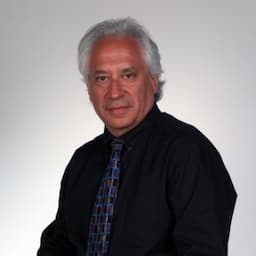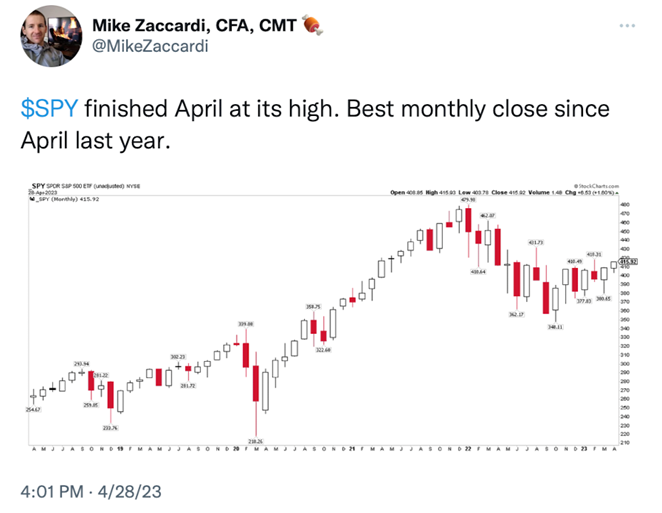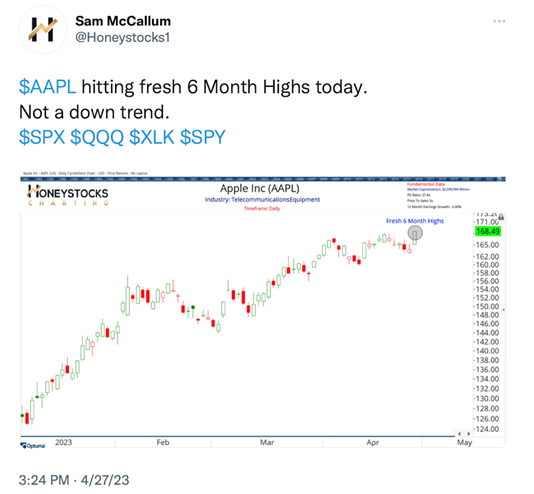Asia stocks rise tracking Wall St gains; RBA minutes, Japan FX stance in focus
Hello Gaugers. Hope you had a good, productive, and profitable week.
There was an abundance of earnings announcements this past week as well as updated economic information.
Can we evaluate how healthy companies are from their earnings announcements? Can we interpret the state of the economy from this information? Let’s explore.
Last week we provided 8 reasons why we thought the market could continue to climb higher or climb the wall of worry. The beginning of the week looked shaky from negative expectations from upcoming tech earnings. We witnessed a couple of heavily negative days. Some traders suspected we had finally broken out of the sideways malaise and that the S&P 500 was headed South.
Not so fast.
Recall some of the reasons we wrote about last week suggesting that the market might continue higher. A refresher:
- The PMI (Purchasing Manager Indicator) had turned up.
- Other economic indicators were looking more positive.
- The number of S&P (and NDX) stocks over their 50-day moving average were increasing.
- Negative sentiment readings as well as large positions of puts being held by traders. This could trigger a short covering rally (we suspect it may have contributed to Thursday’s big day up).
- Active investment managers are putting $ to work and have committed more $ to stocks (less cash holding by institutional managers).
- The 128 days of an upward move. That is a positive indicator that the market is on solid ground and can move higher.
- Favorable investment period. November to April (especially in pre-election years) is a positive period for stocks.
- The last week of April tends to be good historically. Also we were in the sweet spot of the month when retirement money and rebalancing takes place.
After a few days early in the week of weakness, Thursday began with an economic update on GDP. Forecasted to come in at 2.0% or higher, it surprised everyone coming in weaker than expected at 1.1%.
Most analysts and talking heads interpreted this as a slowing (stalling) economy which may help the Fed to pause sooner than later. Bad news was good news! The market celebrated the second best day of 2023. See chart below:
The S&P finished the week up 1.0% and the tech heavy QQQ was up a little better than 1%. It was a good week to turn off some of the news (and noise) and stay invested.
The effect of earnings season
Remember this is earnings season, and as we pointed out last week, this was going to be a week where numbers would speak volumes about the state of corporate America. More importantly, these earnings announcements would also tell us about what the management of corporations are predicting for their future business and the overall economy. There was also a heightened acuity about what might be said on their post earnings announcement conference calls.
A good illustration of the power of these conference calls was best exemplified by Amazon (NASDAQ:AMZN) on Thursday. Their earnings numbers beat (by a wide margin) the analyst expectations (and whisper numbers). The stock was up in after hours trading by 7-8%, a big move for a behemoth company. However, what they said in their conference call was negative. They expect a slowdown in the economy will likely have a negative effect on their customers’ use of AWS (Amazon Web Services). AWS historically has been one of the most profitable arms of Amazon. Amazon’s guidance reiterated the slowing GDP number issued earlier in the day. Instead of the stock being up on Friday 7-8%, the stock closed down 4%.
Good news turned into bad news turned into good news?
How can that be? Amazon’s good earnings with negative commentary (bad news) turned into the market interpreting this as the long-awaited corporate earnings slowdown that the Fed has been anticipating. That translated into expectations for a Fed pause or even interest rate cuts later in 2023. The overall market rallied, and bonds had a good day!
A week of dichotomies.
Multiple companies in the same or similar industries reported very different and contradictory earnings numbers. One company reported a huge earnings beat followed by an upbeat conference call (Meta Platforms (NASDAQ:META), Microsoft (NASDAQ:MSFT), Exxon Mobil (NYSE:XOM)). And their stocks took off.
Other companies reported earnings misses, a pessimistic tone (First Republic Bank (NYSE:FRC), First Solar (NASDAQ:FSLR), Snap (NYSE:SNAP), Amazon (NASDAQ:AMZN)) and their stocks closed negative or got clobbered (FRC, SNAP). Amazon as illustrated above was one of the best examples of a company dichotomy. Report good earnings but negative guidance news.
Earnings Update
According to FactSet, 53% of S&P 500 companies have reported their Q1 2023 results with 79% beating their earnings estimates and 74% reporting revenues above estimates.
PLEASE be aware, however, that ALL earnings expectations were ratcheted down given the economic slowdown that is occurring coupled with higher operating costs. Most analysts, CFAs and research houses still believe that the market is selling at a lofty multiple and they continue to warn that the overall market should be valued at lower prices.
We can’t comment only to offer that as Mr. Wonderful says on Shark Tank: “Money always goes to where it is treated best”
Earnings Expectations:
We would also suggest you go back and revisit our Market Outlooks that address how to evaluate fair value of the stock market. As you may be aware, I came from a long career with a traditional stock manager who evaluated every stock’s future earnings and conveyed to clients, especially those institutionally, what the earnings might look like in the near future.
A quick formula that works well (and gives an accurate reading) is to apply a reasonable multiple to current S&P earnings. According to Y Charts, the current S&P earnings are $187 (a share) and then multiplied by a fair multiple (we would use historical averages of 17x-20x, especially if we are in a slowdown with elevated interest rates). That current range would be approximately 3179-3740.
Of course, the stock market is forward looking and is often valued on the growth of earnings and WHAT future earnings might look like 2-4 quarters out. Using that as our guide, and a very liberal rate of growth of 10-12% in earnings (not likely to happen if we have a slowing economy), that would put estimates at 3800-4200 on the S&P 500. We currently are at 4169. Is there a lot of upside? This is the important question investors need to ask.
Upcoming Apple Earnings This Week
Apple (NASDAQ:AAPL) will announce its earnings this coming week. I suspect that it will either propel the market higher or sink it quickly. Most analysts are hoping that Apple can support the good news that other mega-cap technology stocks have experienced so far (META, MSFT, AMZN and others).
If you are watching for any sign that Apple may deliver the “goods”, please note that Apple stock hit a 6 month high on Friday. The chart looks far more positive than negative. Maybe the news they will deliver is already baked in the cake. See chart below:
In The Danger Zone (Growing Concerns)
We make every attempt to look at the macro environment with a fair and balanced outlook, However, there are meaningful issues on the table at this moment. In some respect I feel that we are in the “Danger Zone” and operating out on the edges. Reminds me of Verse 3 of Kenny Loggins great song “Danger Zone” used in the Top Gun movies:
“Out along the edges
Always where I burn to be
The further on the edge
The hotter the intensityHighway to the Danger Zone
Gonna take it right into the Danger Zone
Highway to the Danger Zone
Ride into the Danger Zone”
A popular phrase used among investors and analysts is “the bond market is always right”. If that is so, there is no doubt that the bond market right now is calling for a recession. Earlier in the year, the bond market forecasted a 25 basis point raise.
However, this past week the PCE (Personal Consumption Expenditure) came in hotter than expected. Faced with persistently high inflation, we now are looking at perhaps not one but likely 2 more 25 basis point rises. At least that was the takeaway from a prank phone call Jerome Powell had with phony foreign economists this past week.
The Fed’s Expectations
The Fed has revised its economic forecasts several times in the past few months. They are now expecting GDP for 2023 to come in at 0.4% (avoiding a recession and indicating a soft landing). If true, with the latest report of 1.1% for the 1st quarter, we would have to incur negative growth in the economy for the next few quarters.
The Fed is also expecting that their actions will cause unemployment to eventually get to 4.5% which would mean 1,600,000 workers would become unemployed.
Other Issues
There is a long list of some serious economic and geopolitical risks hanging over the economy at the present time. We state this just so you have a realistic picture of the possible areas that could derail the economy. A few to consider:
- The third largest regional bank collapsed over the past week. First Republic Corp (FRC) will be taken over by the FDIC this weekend. They are hoping that either PNC Bank or JP Morgan buys the bank’s assets.
- Commercial real estate is showing significant weakness. More than a few large commercial buildings are being taken over by the banks and holders of the loans on these buildings. Some of this was exacerbated by employees not wishing to come back to work in the office setting as well as companies accommodating employees who wish to work remotely.
- Bankruptcies and reorganizations continue to climb. Last week Bed, Bath and Beyond effectively called it quits. They have hundreds of stores and many leases that will affect smaller strip center owners.
- Credit card debt is rising.
- Delinquent car loans are accelerating.
- CDS (Collateralized Debt Swaps) which are used to insure investments have climbed dramatically in price.
Too few stocks are driving the markets
The five largest stocks are responsible for the majority of the S&P 500’s gain this year. In fact, the margin between the market cap weighted S&P 500 and the equal weighted S&P 500 is 5%, the widest gap in 34 years. 2020 saw this gap at 2% and the only other year that was better than 2% was 1997. It is important to note that both those years saw a yearly return of greater than 20%. See chart below:
This narrowing of breadth is a negative on the markets and it must be resolved soon, or the market may be facing a nasty correction. See chart below:
Stagflation
As our own Mish has pointed out on numerous occasions through her Mish’s Daily or on her national TV appearances since late 2021, “we are now faced with one of the worst economic scenarios playing out-STAGFLATION”. While this is hardly a new idea for MarketGauge, it seems to have caught on in the press recently. The lead off story this week from Fortune was as follows:
Stagflation is a bad economic condition where unemployment stays stubbornly low, growth rates in the economy are basically non-existent and inflation continues to erode purchasing power as companies cannot deliver wage gains while they are battling higher costs. The stock market typically goes sideways in this type of economic environment. Look at 1973 to 1981 for an example of this type of investing environment. It’s the worst of all possible scenarios.
Last Thursday’s economic numbers of a slowing economy with a GDP number well below expectations coupled with the PCE coming in slightly higher than expected was the worst possible news. To us it also signals that there is likely no possible rate cuts by the Fed in 2023.
And Morgan Stanley’s chief U.S. economist Ellen Zentner said Thursday that after a “modest step down” in economic growth in the first quarter, she is “tracking” second-quarter GDP growth at negative 0.4%. “We expect to see significant slowing into 2Q23 as the cumulative effect of tighter monetary policy as well as banking pressures push growth into negative territory,” she wrote in a note to clients.






